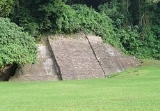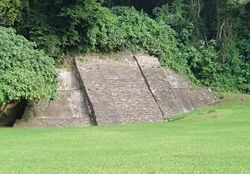
Cuyuxquihui
Encyclopedia
 |
|
| Name: | Cuyuxquihui |
| Location | Paso de Correo, Papantla Papantla Papantla is a city and municipality located in the north of the state of Veracruz, Mexico, in the Sierra Papanteca range and on the Gulf of Mexico. The city was founded in the 13th century by the Totonacs and has dominated the Totonacapan region of the state since then... , Veracruz Veracruz Veracruz, formally Veracruz de Ignacio de la Llave officially Estado Libre y Soberano de Veracruz de Ignacio de la Llave , is one of the 31 states that, along with the Federal District, comprise the 32 federative entities of Mexico. It is divided in 212 municipalities and its capital city is... |
| Coordinates | 20°18′17.83"N 97°15′43.94"W |
| Culture | Totonac Totonac The Totonac people resided in the eastern coastal and mountainous regions of Mexico at the time of the Spanish arrival in 1519. Today they reside in the states of Veracruz, Puebla, and Hidalgo. They are one of the possible builders of the Pre-Columbian city of El Tajín, and further maintained... – Tepehua Tepehua Tepehua may refer to:* Tepehua language belongs to Totonacan languages* Tepehuan language belongs to Uto-Aztecan languages... |
| Period | Postclassical |
| Foundation | Around 1,250 CE. |
| Decline | Final Postclassical |
| Language | Totonac Totonacan languages The Totonacan languages are a family of closely related languages spoken by approximately 200,000 Totonac and Tepehua people in the states of Veracruz, Puebla, and Hidalgo in Mexico... |
| INAH Official Page | Not available |
Cuyuxquihui is an archaeological site located in the Tecolutla valley, in the region of the Totonac
Totonac
The Totonac people resided in the eastern coastal and mountainous regions of Mexico at the time of the Spanish arrival in 1519. Today they reside in the states of Veracruz, Puebla, and Hidalgo. They are one of the possible builders of the Pre-Columbian city of El Tajín, and further maintained...
culture, about 14 miles (22 kilometers) southeast of El Tajín
El Tajín
El Tajín is a pre-Columbian archeological site and was the site of one of the largest and most important cities of the Classic era of Mesoamerica. The city flourished from 600 to 1200 C.E. and during this time numerous temples, palaces, Mesoamerican ballcourts and pyramids were built...
, two kilometers from the “Paso de Correo” town, in the Veracruz
Veracruz
Veracruz, formally Veracruz de Ignacio de la Llave officially Estado Libre y Soberano de Veracruz de Ignacio de la Llave , is one of the 31 states that, along with the Federal District, comprise the 32 federative entities of Mexico. It is divided in 212 municipalities and its capital city is...
State, Mexico.
The name of Cuyuxquihui is a composed word from the totonaca language
Totonacan languages
The Totonacan languages are a family of closely related languages spoken by approximately 200,000 Totonac and Tepehua people in the states of Veracruz, Puebla, and Hidalgo in Mexico...
; cuyu, armadillo
Armadillo
Armadillos are New World placental mammals, known for having a leathery armor shell. Dasypodidae is the only surviving family in the order Cingulata, part of the superorder Xenarthra along with the anteaters and sloths. The word armadillo is Spanish for "little armored one"...
and quihui, wood
Wood
Wood is a hard, fibrous tissue found in many trees. It has been used for hundreds of thousands of years for both fuel and as a construction material. It is an organic material, a natural composite of cellulose fibers embedded in a matrix of lignin which resists compression...
and it points to the similarity of the local fauna to the shell of that animal.
“Totonaca” also is an Administrative Region in the Veracruz State, includes the Tecolutla valley and it is rich in prehispanic archeological sites, presumably constructed by the Totonacs, which lived next to the sea. The Tajín is one of those settlements.
This site it is about 74.29 kilometres (46.2 mi) southwest from Las Higueras (archaeological site), another Totonac site in the region.
The Totonacs
The Totonac Culture, whose name is possibly translated as "three hearts", likely referring to three centers of this culture:- El Tajín (300-1200), maximum exponent of the totonacs culture splendor
- Papantla (900-1519).
- Zempoala (900-1519).
This culture had a large ceramic variety and stone sculpture, monumental architecture and cities with an advanced urban concept.
The Totonac Languages are a family of closely related languages spoken by approximately 200,000 Totonac and Tepehua
Tepehua
Tepehua may refer to:* Tepehua language belongs to Totonacan languages* Tepehuan language belongs to Uto-Aztecan languages...
people in the states of Veracruz, Puebla, and Hidalgo in Mexico. The Totonacan languages are not demonstrably related to any other languages, although they share numerous areal features with other languages of the Mesoamerican Sprachbund, such as the Mayan languages and Nahuatl.
The site
This settlement would seem to have been a fortress, due to some architectonic characteristics; the existence of retaining walls that run throughout the esplanade north to south has been confirmed; its height makes it relatively inaccessible from the west, as well as by the cliff that borders it to the east. It is believed it was required due to the large social mobility that ensued after the fall of Tajín.Material remains on the various regional settlements, leads to believe that a good part of them were El Tajín contemporaries and that some developed after its gradual abandonment. Evidence seem to indicate that the Cuyuxquihui settlement was founded in 1250 CE.
Cuyuxquihui developed, after the El Tajín decline, as an important ceremonial activities center. Diverse structures were constructed by means of ground surface leveling, construction element characteristic of the “Tajín Chico” site. The first constructions used selected materials, which were applied with mortar elements and subsequently were finished with gross stucco and painted.
Cuyuxquihui was conquered by the Aztecs, Moctezuma Ilhuicamina (1398 – 1469) towards 1465, probably one of the most important reasons of the cultural mix of the totonac elements, mexicas and huastecos.

